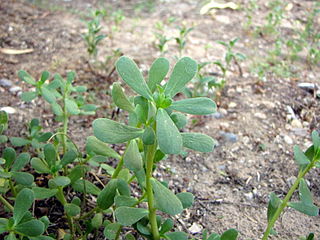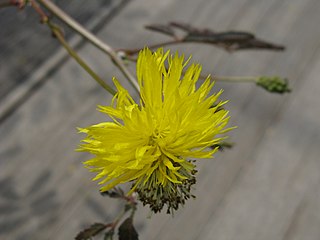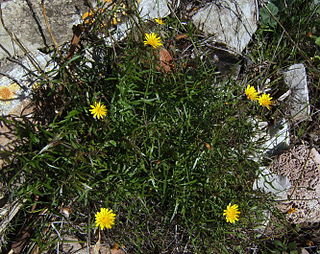
Cirsium oleraceum, the cabbage thistle or Siberian thistle, is a species of thistle in the genus Cirsium within the family Asteraceae, native to central and eastern Europe and Asia, where it grows in wet lowland soils.

Portulaca oleracea is an annual succulent in the family Portulacaceae.

Brassica oleracea is a plant species from family Brassicaceae that includes many common cultivars used as vegetables, such as cabbage, broccoli, cauliflower, kale, Brussels sprouts, collard greens, Savoy cabbage, kohlrabi, and gai lan.

Sonchus is a genus of flowering plants in the tribe Cichorieae within the family Asteraceae and are commonly known as sow thistles. Sowthistles are annual, biennial or perennial herbs, with or without rhizomes and a few are even woody.

Leaf vegetables, also called leafy greens, pot herbs, vegetable greens, or simply greens, are plant leaves eaten as a vegetable, sometimes accompanied by tender petioles and shoots. Leaf vegetables eaten raw in a salad can be called salad greens.

Assamese cuisine is the cuisine of the Indian state of Assam. It is a style of cooking that is a confluence of cooking habits of the hills that favour fermentation and drying as forms of preservation and those from the plains that provide extremely wide variety of fresh vegetables and greens, and an abundance of fish and meat. Both are centred on the main ingredient — rice. It is a mixture of different indigenous styles with considerable regional variations and some external influences. The traditional way of cooking and the cuisine of Assam is very similar to South-East Asian countries such as Thailand, Burma (Myanmar) and others. The cuisine is characterized by very little use of spices, little cooking over fire, and strong flavours due mainly to the use of endemic exotic fruits and vegetables that are either fresh, dried or fermented. Fish is widely used, and birds like duck, pigeon, squab, etc. are very popular, which are often paired with a main vegetable or ingredient; beef used to be eaten before British colonialism, and some continue to do so. Preparations are rarely elaborate. The practice of bhuna, the gentle frying of spices before the addition of the main ingredients so common in Indian cooking, is absent in the cuisine of Assam. The preferred oil for cooking is the pungent mustard oil.

Maror are the bitter herbs eaten at the Passover Seder in keeping with the biblical commandment "with bitter herbs they shall eat it.". The Maror is one of the symbolic foods placed on the Passover Seder plate.

Sonchus asper, the prickly sow-thistle, rough milk thistle, spiny sowthistle, sharp-fringed sow thistle, or spiny-leaved sow thistle, is a widespread flowering plant in the tribe Cichorieae within the family Asteraceae.

Lactuca serriola, also called prickly lettuce, milk thistle, compass plant, and scarole, is an annual or biennial plant in the tribe Cichorieae within the family Asteraceae. It has a slightly fetid odor and is commonly considered a weed of orchards, roadsides and field crops. It is the closest wild relative of cultivated lettuce.

Tetragonia tetragonioides, commonly called New Zealand spinach, Warrigal greens and other local names, is a flowering plant in the fig-marigold family (Aizoaceae). It is often cultivated as a leafy vegetable.

Namul refers to either a variety of edible grass or leaves or seasoned herbal dishes made of them. Wild greens are called san-namul, and spring vegetables are called bom-namul. On the day of Daeboreum, the first full moon of the year, Koreans eat boreum-namul with five-grain rice. It is believed that boreum namuls eaten in winter help one to withstand the heat of the summer to come.

Alternanthera sessilis is a flowering plant known by several common names, including sissoo spinach, Brazilian spinach, sessile joyweed, dwarf copperleaf. It is cultivated as a vegetable worldwide.

Sonchus arvensis, the field milk thistle, field sowthistle, perennial sow-thistle, corn sow thistle, dindle, gutweed, swine thistle, or tree sow thistle, is a species of flowering plant in the family Asteraceae. S. arvensis often occurs in annual crop fields and may cause substantial yield losses.

Lepidium oleraceum is a herb in the family Brassicaceae, endemic to New Zealand. Its English common name is Cook's scurvy grass; Māori names include nau, ngau, naunau and heketara.

Neptunia oleracea, commonly known in English as water mimosa or sensitive neptunia, is pantropical nitrogen-fixing perennial legume. Genus and common name come from Neptune, god of the sea, in reference to the aquatic habit of some species in the genus.

Roystonea oleracea, sometimes known as the Caribbean royal palm, palmiste, imperial palm or cabbage palm, is a species of palm which is native to the Lesser Antilles, Colombia, Venezuela, and Trinidad and Tobago. It is also reportedly naturalized in Guyana and on the islands of Mauritius and Réunion in the Indian Ocean.

Sonchus tenerrimus is a species of flowering plant in the family Asteraceae known by the common name slender sowthistle. It is native to the Mediterranean region of southern Europe, northern Africa, and the Middle East. It has been found as well in several other locations around the world, historically in association with ship ballast in coastal regions. It has become naturalized in a few places, such as California in the United States and Baja California in Mexico.

Acmella oleracea is a species of flowering herb in the family Asteraceae. Common names include toothache plant, Szechuan buttons, paracress, jambu, buzz buttons, tingflowers and electric daisy. Its native distribution is unclear, but it is likely derived from a Brazilian Acmella species. A small, erect plant, it grows quickly and bears gold and red inflorescences. It is frost-sensitive but perennial in warmer climates.

Spring greens, or spring vegetables, are the edible young leaves or new plant growth of a large number of plants that are most fit for consumption when their newest growth happens in the spring. Many leaf vegetables become less edible as they age and bitter, or potentially even toxic, compounds start to form. Harvesting of spring vegetables is common across Native American cultures.

Sonchus kirkii, also known as New Zealand sow thistle, or shore puha is a herb in the Asteraceae family. It grows in coastal New Zealand.























